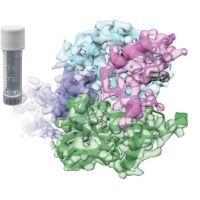Specification
| Description | Recombinant protein from the full-length sequence of Homo sapiens G protein subunit alpha transducin 3 (GNAT3) (NM_001102386). |
| Organism | Homo sapiens (Human) |
| Expression Host | Human Cells |
| Tag Info | His or DYKDDDDK. Please contact us if you need further information or require specific designed tag. |
| Purity | Greater than 90% by SDS-PAGE gel |
| Uniprot ID | A8MTJ3 |
| Entry Name | GNAT3_HUMAN |
| Gene Names | GNAT3 |
| Alternative Gene Names | |
| Alternative Protein Names | Guanine nucleotide-binding protein G(t) subunit alpha-3 (Gustducin alpha-3 chain) |
| Application | Antigens, Western, ELISA and other in vitro binding or in vivo functional assays, and protein-protein interaction studies; For research & development use only! |
| Buffer | Purified protein formulated in a sterile solution of PBS buffer, pH7.2, without any preservatives |
| Endotoxin | Endotoxin level is < 0.1 ng/µg of protein (<1EU /µg) |
| Length | 354 |
| Molecular Weight(Da) | 40357 |
| Protein Sequence | (The sequence of expressed protein may have some variation from the sequence shown below. Please contact us for the exact sequence.) MGSGISSESKESAKRSKELEKKLQEDAERDARTVKLLLLGAGESGKSTIVKQMKIIHKNGYSEQECMEFKAVIYSNTLQSILAIVKAMTTLGIDYVNPRSAEDQRQLYAMANTLEDGGMTPQLAEVIKRLWRDPGIQACFERASEYQLNDSAAYYLNDLDRITASGYVPNEQDVLHSRVKTTGIIETQFSFKDLHFRMFDVGGQRSERKKWIHCFEGVTCIIFCAALSAYDMVLVEDEEVNRMHESLHLFNSICNHKYFSTTSIVLFLNKKDIFQEKVTKVHLSICFPEYTGPNTFEDAGNYIKNQFLDLNLKKEDKEIYSHMTCATDTQNVKFVFDAVTDIIIKENLKDCGLF |
Background
| Function | FUNCTION: Guanine nucleotide-binding protein (G protein) alpha subunit playing a prominent role in bitter and sweet taste transduction as well as in umami (monosodium glutamate, monopotassium glutamate, and inosine monophosphate) taste transduction. Transduction by this alpha subunit involves coupling of specific cell-surface receptors with a cGMP-phosphodiesterase; Activation of phosphodiesterase lowers intracellular levels of cAMP and cGMP which may open a cyclic nucleotide-suppressible cation channel leading to influx of calcium, ultimately leading to release of neurotransmitter. Indeed, denatonium and strychnine induce transient reduction in cAMP and cGMP in taste tissue, whereas this decrease is inhibited by GNAT3 antibody. Gustducin heterotrimer transduces response to bitter and sweet compounds via regulation of phosphodiesterase for alpha subunit, as well as via activation of phospholipase C for beta and gamma subunits, with ultimate increase inositol trisphosphate and increase of intracellular Calcium. GNAT3 can functionally couple to taste receptors to transmit intracellular signal: receptor heterodimer TAS1R2/TAS1R3 senses sweetness and TAS1R1/TAS1R3 transduces umami taste, whereas the T2R family GPCRs act as bitter sensors. Functions also as lumenal sugar sensors in the gut to control the expression of the Na+-glucose transporter SGLT1 in response to dietaty sugar, as well as the secretion of Glucagon-like peptide-1, GLP-1 and glucose-dependent insulinotropic polypeptide, GIP. Thus, may modulate the gut capacity to absorb sugars, with implications in malabsorption syndromes and diet-related disorders including diabetes and obesity. {ECO:0000269|PubMed:11917125, ECO:0000269|PubMed:17724330}. |
| Pathway | |
| Protein Families | G-alpha family, G(i/o/t/z) subfamily |
| Tissue Specificity | Expressed in taste buds (sensory organs of clustered epithelial cells) of the circumvallate and foliate papillae of the tongue at protein level. Expressed in enteroendocrine L cells of the gut. Detected also in spermatozoa. {ECO:0000269|PubMed:16728727, ECO:0000269|PubMed:17021831, ECO:0000269|PubMed:17724332, ECO:0000269|PubMed:8015379}. |
QC Data
| Note | Please contact us for QC Data |
| Product Image (Reference Only) |  |

